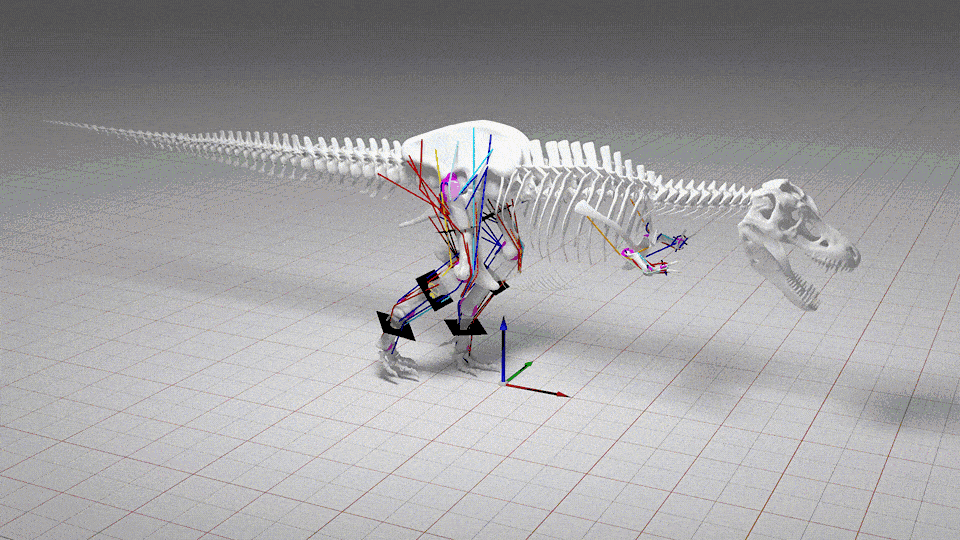When you buy through links on our site , we may earn an affiliate commission . Here ’s how it works .
Tyrannosaurus rexmay have been the world ’s first power - footer , using its lengthy leg to relentlessly pursue fly prey , new research has found .
Walking , the scientists discovered , would have been an energy - efficient hunt scheme for bigdinosaurslike tyrannosaurs .

In this artist’s depiction of life 77 million years ago in Alberta, Canada, the tyrannosaur Daspletosaurus hunts a young horned Spinops. An adult Spinops tries to interfere, and a Coronosaurus watches from a distance.
To well understand walk and play inT. rexand other bird-footed dinosaur , or center - eating dinosaur , scientist measure metrics such as comparative limb size of it , position and body mass in 93 individual dinosaurs from 71 theropod coinage , for figure how those factors may have affected the brute ' maximum pep pill .
They found that while long - leggedness made some theropods dissipated runners , that was n’t always the case . In very bombastic dinosaur , such asT. rex , retentive limb came with a different reward , allowing the predator to keep up a slower but unbendable stride long after a speedy animal would have grow hackneyed and given up the chase .
Related : Image gallery : The aliveness of T. male monarch

" The assumption tends to be that animals with adjustment for course , such as long legs , are adapted for a eminent maximal speed , but this paper shows that there ’s more to running than top amphetamine , " said study co - writer Thomas Holtz , a master lector in the University of Maryland ’s Department of Geology .
" When you ’re a bigger animal , those adaptations may also be for endurance and efficiency , " Holtz saidin a statement . " It may be about being a long-distance runner rather than a sprinter . "
Theropods were a extremely successful group of sublunary dinosaur that dominatedthe Mesozoic era(252 million to around 66 million years ago ) , and bipedalism — walk on two legs — is retrieve to have play a big part in their success , the scientist wrote . In the study , they appear at theropods in a chain of sizes : from pipsqueaks that librate less than 11 lbs . ( 5 kilograms ) toT. rexbehemoths that weighed more than 20,000 lbs . ( 9,000 kilogram ) . They measure the dinosaur ' hip height , body distance and tree branch bone distance , and estimated the bird-footed dinosaur ' energy requirements .

A foraging advantage
In minor and medium - size of it bird-footed dinosaur , having longsighted legs did increase speediness , according to the researchers ' calculations . For a not - so - with child dinosaur , being a firm ball carrier would have help it not only catch prey , but also duck larger vulture .
But that speedy vantage declined in bigger , heavier dinosaurs that weighed more than 2,200 lbs . ( 1,000 kg ) , even when they had farseeing legs , the scientists identify . In large bird-footed dinosaur , long legs represented greater Department of Energy efficiency and reduced energy cost while foraging — roaming around on the sentinel for prey , sometimes for 60 minutes at a stretch .
" That ’s actually a very beneficial rescue , because predator tend to expend a dandy wad of their sentence forage , " Holtz say in the statement . " If you are burning less fuel during the foraging part of the day , that ’s an energy savings that dinosaurs with short wooden leg form did n’t get . "

Even ifT. rexwasn’t a firm runner , it was still subject of plow very apace to champ down on turn tail prey , pivoting in a venomous pirouette like a " form skater from hell , " Live Science antecedently reported .
As a group , tyrannosaurs incline to be both large and long - legged , more so than other theropods , according to the study . But did " legginess " in Tyrannosaurus rex come forth in the group over meter , or was it an ancestral trait keep back by all tyrannosaur — even the group ’s biggest metal money , such asT. rex ?
For now , it ’s difficult to say . Yet both selection " present interesting evolutionary scenarios " and pinch at panoptic conditional relation for understanding not only tyrannosaurs but also the ancient ecosystems where these deathly predators ruled the land , the researchers said .

The finding were bring out online May 13 in the journalPLOS One .
Originally published onLive Science .
OFFER : Save 45 % on ' How It work ' ' All About Space ' and ' All About story ' !

For a limited metre , you could take out a digital subscription to any ofour best - sell science magazinesfor just $ 2.38 per calendar month , or 45 % off the standard monetary value for the first three month .











